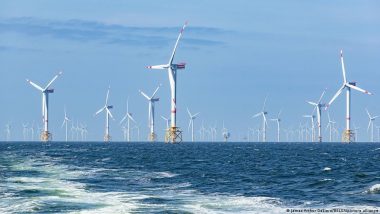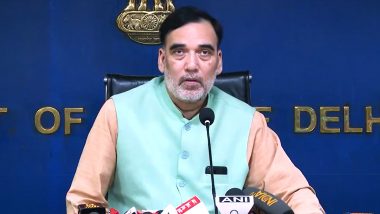The EU’s climate advisory board has recommended the bloc adopt ambitious targets for 2040. Researchers say there are multiple options to slash emissions, with plenty of political wiggle room.The EU aims to be climate neutral by 2050, but exactly how it's going to get there has been the subject of debate for years. EU institutions will soon agree on important interim targets for the period up to 2040. A report published Thursday by the EU climate advisory board provides the scientific basis for these targets, with clear recommendations for Brussels.
Also Read | Jennifer Aniston Is Happy, Healthy and Searching for Love in Her 50s - Reports.
In the report, the European Scientific Advisory Board on Climate, an international and multidisciplinary team of researchers, has recommended the bloc reduce its climate-damaging greenhouse gas emissions by at least 90% — or ideally by 95% — by 2040.
"These reductions are essential for mitigating climate risks and achieving a sustainable future ," the researchers said.
To arrive at their conclusions, the researchers examined more than 1,000 climate scenarios. They looked at feasibility, environmental risks, and the challenges associated with scaling up technologies such as for solar, wind and hydrogen energy in the short-term.
Just five of the scenarios were found to be consistent with both the EU's own emissions targets and its commitments under the Paris climate agreement, while at the same time being technologically feasible and posing little risk to the environment.
A plan to reach climate neutrality by 2050
The EU's climate change advisory board was set up in 2021 as part of the adoption of the European Climate Law.
The law provides a framework for realizing the bloc's medium- and long-term climate goals, set out in the EU Green Deal. The advisory body's role is to provide scientific advice on EU policy measures and recommendations for how the 27 member states can meet their commitments under the Paris climate agreement.
By 2030, the bloc wants to reduce its climate-damaging emissions by 55% compared to 1990 levels. And by 2050, the goal is for Europe's economy and society to be climate neutral. Any emissions produced after that point would have to be offset by measures that remove CO2 from the atmosphere.
That could be achieved, for example, by replanting forests and restoring damaged carbon sinks such as peatlands and peat soils — ecosystems that, when healthy, can store significant amounts of carbon.
Countries are also increasingly investing in carbon capture and storage technology (CCS), which aims to suck carbon from the atmosphere and store it underground. But the technology is considered controversial.
Wiggle room for reaching climate goals
The scientists on the advisory board stress that there is some political room to maneuver to achieve the climate goals. Some of the scenarios rely more on technologies such as CCS and nuclear energy, while others manage without nuclear power altogether.
Ottmar Edenhofer, chairman of the advisory board and chief economist at the Potsdam Institute for Climate Impact Research in Germany, emphasizes that "according to the scenarios, nuclear is not an inevitable option. So here there's room for policy positions."
Laura Diaz Anadon, vice chair of the advisory board, says all options will require careful consideration, flexible mechanisms, and policy guidance.
All scenarios would bring "numerous other benefits, including significant improvements in health and enhanced energy security," she adds.
Crucial to all the promising scenarios is a coal phase-out across Europe by 2030 and a gas phase-out by 2040. These scenarios also envisage a doubling of electric energy in total consumption, and significant market dominance for solar, wind and hydro power.
While technologies such as CCS are not yet fully ready for the market, obstacles in expanding wind turbines and photovoltaic plants "can be overcome with ambitious policy measures," Edenhofer said.
What is fair when it comes to climate protection?
According to the researchers, if the EU follows their recommendations, the bloc would not only be on the path to achieving its goal of "climate neutrality" by 2050. It would also be making a fair contribution to climate protection, given its significant historical contribution to climate change.
But there's still a gap here, the report says. Depending on which calculation model is used, the EU has already used up its CO2 budget in order to stay below the 1.5 degree Celsius limit.
The Global North, and especially Western countries, achieved great prosperity through industrialization over the past century, burning vast amounts of climate-damaging coal, oil and gas in the process.
Today, countries in the Global South are bearing the brunt of the consequences of the climate crisis. As a result, they're demanding that rich countries provide compensation and work towards more ambitious emissions targets.
If the EU wants to pay its fair share in climate protection, the report says it would also have to become more active outside Europe. This could mean, for example, investing in the energy transition or technological support for the development of a solar and wind industry.
EU Green Deal still lagging behind
The EU aims to source 40% of its energy from renewable sources by 2030. It also wants to reduce energy consumption by more than 35% over the same period, electrify transport as much as possible, provide more incentives for retrofitting buildings, and protect natural resources and carbon stores.
"The honest truth is that the world is not on track to keep the temperature rise to 1.5 degrees Celsius," said European Commission Vice-President Frans Timmermans, architect of the Green Deal, in November 2022. "We need more ambition."
At the Sharm El-Sheikh climate conference last November, Timmermans announced that the EU aims to emit at least 55% less CO2 by 2030. But a look at the specific measures currently in place suggests this target won't be met. At best, the EU will be able to save a maximum of 47% by the end of the decade — that's if the members states' policies are fully implemented.
If the 2030 target were met, however, then the 2040 and 2050 targets would also be within reach, says Edenhofer. That pathway "is consistent with the international goals, (and) also consistent with the EU values and the EU legislation," he said. "So in that sense, if these targets will be implemented, I think this would be a huge achievement."
By mid-2024, the European Commission will develop new climate targets for 2040 — based on the advisory board's recommendations, the interests of member states, industry and civil society — and make proposals on how to achieve them.
This text was originally published in German.
(The above story first appeared on LatestLY on Jun 15, 2023 12:30 PM IST. For more news and updates on politics, world, sports, entertainment and lifestyle, log on to our website latestly.com).













 Quickly
Quickly



















